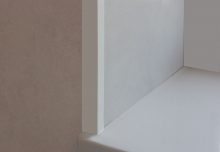
Cladding is about as easy to fit as wall coverings get. But it is always nice to have a few extra tricks up your sleeve when installing anything. So here are some extra bathroom cladding installation tips to help make the process as smooth as possible.
Replacing Existing Wall Fixings
If you are undertaking a refurbishment (as opposed to a new installation) then this is a great little trick.
This works for any fixtures that require screw fixings in the wall. For our example we will use radiator brackets.
- Work your way along the wall fitting the bathroom cladding until you come to the bracket.
- Remove the bracket but leave the wallplugs in place in the wall.
- Cut the next piece of panelling and dry fit it for accuracy.
- When you are happy with the fit remove it.
- Replace the screws into the wallplugs but leave them protrude an inch or so.
- Heat the screws up with a blow torch and quickly dry fit the panel again. The hot screws will melt a hole through the panel in exactly the right place for the brackets.
- Remove the screws, fit the panel with adhesive and refit the bracket using the screw holes that you have just created.
Simple!
This method can then be adapted for use with the pipework supplying your shower mixer. Remove the shower and heat the pipes up to melt their way through the panels. Obviously this only works for copper pipe and where the stubs are not too long.
Make sure you have plenty of ventilation whenever you are melting plastic products and be careful not get your fingers too close to the hot metal when pushing the panel home.
Installing New Items
When fitting items to a wall in a new installation you can do away with having to heat up screws.
This works for any fixtures that require screw fixings in the wall. For our example we will use radiator brackets.
- Work your way along the wall until you come to the place where the item is to be fitted.
- Dry fit a panel at the location.
- Mark the screw holes on the panel
- Carefully drill through the panel to mark the wall behind.
- Remove the panel and drill the wall and fit wall plugs as required
- Replace the panel – the screw holes in the panel should line up with the wall plugs behind.
- Remember to seal any holes if the fixture is inside a shower or bathing area
Before You Fit Your Cladding
Make sure you keep the panels flat. Do not store them leaning against a will as they will develop a curve that will make installation more difficult.
Remove all of the packaging from the cladding and check it for damage. At the same time check the batch numbers printed on the rear of the panels (not the one on the packet) to ensure they are matching. Cladding colours can vary slightly between batches. If you do have some from different batches keep one batch per wall and you will not notice any slight differences.
Some panels need to be installed in a certain order (such as Modern Decor by Vox). Each panel is numbered and needs to be fitted in order – there are full instructions for this type of cladding in each pack.
Bring the panels inside 24 hours before installation. If the panels are cold they are much more likely to chip when being cut as the plastic will be more brittle. The same applies to adhesives and sealants. They will be much more viscous if cold (and some will actually stop working if kept too cold).

Fixing Methods
There are 3 standard fixing methods for bathroom cladding: sticking; stapling; screwing.
It is possible to use any or all of these methods on the same job depending on circumstances.
We all have concerns about the environment these days. Choosing the right fixing method can have an impact on cladding’s footprint. Staples and screws will enable you to remove the panels intact if you ever decide it is time for a change. You can then re-use the panels elsewhere.
If fixing over very uneven surfaces the panels can sometimes creep apart before the adhesive has set. A staple or screw fixed through one of the tongues every few panels or so will prevent this from happening.

Cutting Bathroom Cladding
One of the benefits of bathroom cladding is its ease of installation. It is light to handle and very easy to cut. Most types of saw can be used to cut it but choose a toll with fine teeth where possible. A tenon saw is ideal but a handsaw will work as well providing it is not too coarse.
If fitting the panels on a ceiling a hole-saw on a drill is perfect for cutting the apertures for recessed lighting. Just take your time and do not press to hard when drilling. It is best to practice on a piece of scrap panel first o get a feel for the process. Once you have tried a few times it becomes second nature.
For small intricate cuts you could use a coping saw or trim with a craft knife. It is also possible to use a soldering iron to melt a hole or aperture if required. Again ensure there is adequate ventilation when melting plastic.

Scribing Panels For A Perfect Fit
Not all walls are perfect. They can be out of true or can be uneven. This makes fitting panels into a corner a little tricky.
Luckily, there is a method that you can employ to make sure your panels fit snuggly. It is called scribing and is quite straightforward.
It involves dry fitting a panel leaving a one-panel gap. You then use a piece of scrap panel as a guide to mark the panel that needs to fit against the irregular shape.
See our guide to scribing panels for full details.
We hope some of these bathroom installation tips have been useful. It is not a hard product to work with but a few extra pointers can go a long way. If you have any other ideas please get in touch – we would love to share them with our customers.
0 Comments
Leave a reply
You must be logged in to post a comment.




